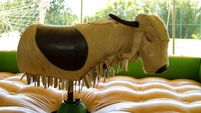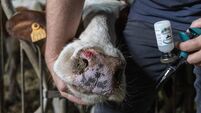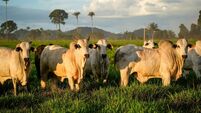The holly and the ringworm - more than an old wives' tale?

Holly boughs tied up in the cow shed on Hazell's farm.
While I was out testing in Ballylanders last week, the festive season was in full swing in the weanling shed, with fresh branches of Holly hanging from the roof.
I was reminded of Professor Michael Doherty’s speech on Irish Farming Folklore at the Cell Check awards in Naas and how the holly bush was used for Ringworm prevention.
There was a resounding chatter of agreement when the professor put up the slide showing Holly tied up in the sheds. I know on our farm, Holly would have always been a feature of our young stock shed.
And I can confirm cattle in the shed in Ballylanders had any sign of Ringworm - a coincidence or consequence?
Ringworm is a fungal skin infection caused by Trichophyton verrucosum, and on rare occasions, Trichophyton mentagrophytes. Contrary to its name, there is no worm of any description involved in its aetiology.
Keeping the amount of wood in the shed to a minimum can also reduce the potentially high exposure of the fungus to young stock.
The classic presentation of circular, grey, hairless and scaly lesions is well-recognisable to most farmers. They are usually present on the head and neck due to cattle rubbing their heads against posts and feed barriers; however, they can extend down the body.
It is no surprise that Ireland’s humid climate is ideal for the spread of the fungus, especially during housing, as there is little sunlight to kill fungus also.
Ringworm is associated with young stock that may be immunosuppressed, meaning the fungus has more potential to cause greater damage.
Making sure young stock are healthy with no underlying infectious or nutritional imbalances can aid in ringworm control. Last year we had an outbreak in our maidan heifers at grass which was unusual, perhaps not being affected as youngstock had meant they were naïve to infection.
Ringworm is also zoonotic. I have been very lucky so far in my life to have avoided infection, but I know many farmers and vets that have not been so lucky. If you suspect you have picked up ringworm on the farm, always seek your doctor’s advice. Other species such as farm dogs, cats and horses can show clinical signs; again be vigilant when the infection is present on the farm.
The treatment options of ringworm for cattle are limited; a topical application of Enilconazole is licensed that needs to be applied three or four times at three days apart each. This can be very labour-intensive on farms, especially with a large outbreak. The main downside of a topical treatment can be the ability of the product to soak into the lesion, especially with excessive scaling and crusting.
There is a vaccine available in Ireland that can both reduce clinical signs of existing infection and act as a preventative treatment. It is a two-dose primary vaccination programme with the booster dose given two weeks later after the first dose. The volume of the injection varies with age, so always consult with your vet before use in your herd.
So, you might wonder, how does a holly branch feature in ringworm’s story? It is reported in old Irish folklore that the leaves contain an antidote powder for the Ringworm fungal spores.
There is a little debate on whether it is the female or male holly bush - or even both, as my Dad has always used. The farmer I was testing for last week said to make sure there were no berries, which would suggest the male Holly was favoured, at least on his farm. And I have read on my extensive internet search of “Holly and Ringworm” that the male Holly has larger leaves, so perhaps more antidote powder is present.
At home, the cows are all officially dry now; so it’s time to enjoy the festive season and the temporary quieter pace of life.
Thank you, the readers, for your continued support, I wish you all a magical Christmas and a Happy New Year.
- Hazell Mullins BVM BVS, is a large animal vet based in Carrignavar, Co Cork.













